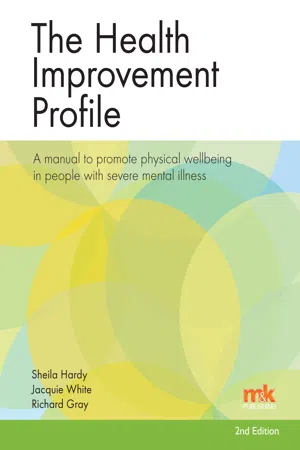![]()
What is severe mental illness? | chapter
1 |
Severe mental illness (SMI) is also known in the literature as severe and persistent mental illness or serious mental illness. It includes schizophrenia, bipolar disorder and other psychoses. In this chapter we talk about two main conditions (schizophrenia and bipolar disorder). Other psychoses include schizotypal personality, persistent delusional disorder, acute/transient psychotic disorders, induced delusional disorders, schizoaffective disorders, manic episodes, severe depression with psychosis and non-organic psychosis. These conditions are not explained individually in this book, as they all share symptoms with schizophrenia or bipolar disorder. Mental illnesses, such as depression and eating disorders, are not discussed either because the care of people with SMI is considered separately in United Kingdom (UK) guidance (NICE 2014a, 2014b, BMA and NHS Employers 2014).
Schizophrenia
Schizophrenia is a psychotic disorder characterised by positive, negative and cognitive symptoms (see Table 1.1). Positive symptoms include hallucinations (hearing voices or seeing visions), delusions (beliefs held strongly by the person but not shared by people around them) and thought disorder (for example, conversation jumping from one thought to another completely unrelated thought). Social isolation and withdrawal are examples of negative symptoms.
Cognitive symptoms are very common and include problems with concentration and planning tasks. Schizophrenia is a long-term condition and life expectancy is reduced by around 20 years compared to the general population (Wahlbeck et al. 2011). About two-thirds of excess mortality is due to natural causes, including cardiovascular disease, cancer, respiratory, and lung diseases (Colton & Manderscheid 2006). The symptoms of schizophrenia often result in major social or occupational disturbance. For example, few people with schizophrenia are in employment (Rosenheck et al. 2006).
Table 1.1: Symptoms of schizophrenia
Positive symptoms (that are not normal for the person):
•Hallucinations
•Delusions
•Thought disorder.
Negative symptoms (that the person doesn’t usually experience):
•Poor motivation
•Social isolation
•Withdrawal.
Cognitive symptoms:
•Impaired attention and memory
•Difficulty with forward planning and problem solving.
Affective or mood symptoms:
•Signs of depression and/or anxiety.
Epidemiology
Schizophrenia is not a common illness but it affects approximately one person in a hundred at some point in their lives (Saha et al. 2008). A meta-analysis of international studies of schizophrenia using pooled data found a prevalence estimate of 4.2 per 1000 (Saha et al. 2008).
Onset tends to be when people are in their teens to early twenties, and although schizophrenia is equally common in men and women, men tend to develop the illness when they are younger than women. This may be explained by the female hormone oestrogen having a protective effect against schizophrenia (Bergemann et al. 2012).
Causes
Around 50 per cent of the cause of schizophrenia can be attributed to genetics (Tsuang et al. 2001). It occurs in 10 per cent of people who have a first-degree relative with the disorder, and is still more likely to develop in those who have second-degree relatives with the disease than in the general population. The identical twin of a person with schizophrenia has a 40–65 per cent chance of developing the disorder (Cardno & Gottesman 2000). Several genes are associated with an increased risk of schizophrenia (Harrison & Weinberger 2005).
Research has found that people with schizophrenia have higher rates of rare genetic mutations involving hundreds of different genes (Walsh et al. 2008). Other recent studies suggest that schizophrenia may result when a gene malfunctions that is needed to make important brain chemicals. This problem may affect the part of the brain involved in developing higher functioning skills (Huang et al. 2007).
Interactions between genes and the environment are necessary for schizophrenia to develop. Many environmental factors may be involved, such as exposure to viruses or malnutrition before birth, problems during birth, and other unknown psychosocial factors (Tsuang et al. 2001).
An imbalance in the complex, interrelated chemical reactions of the brain involving the neurotransmitters dopamine and glutamate, and possibly others, also plays a role in schizophrenia. Studies of brain tissue after death have revealed changes in the distribution or characteristics of brain cells (leading to faulty connections) that could have occurred before birth (Mueser & McGurk 2004). The problem may not manifest in a person until puberty when the brain undergoes major changes; these changes can then trigger psychotic symptoms.
In a study of 229 people with schizophrenia, the majority had prominent positive symptoms and a sudden onset of disease, with 69 per cent of the cases having a record of heavy cannabis abuse at least one year before onset of psychotic symptoms. The authors argue that the high number of cases of schizophrenia in this cohort, and the temporal link between cannabis abuse and schizophrenia, supports the hypothesis that cannabis abuse may be a risk factor for schizophrenia (Allebeck et al. 1993). More recent studies support this hypothesis (Myles et al. 2012).
Early detection of schizophrenia
Making a diagnosis of schizophrenia requires psychotic symptoms to be present for at least a month (American Psychiatric Association 2013). Early detection and treatment is essential in order to ensure that persons are effectively treated as quickly as possible. Intervening early can improve the outcome of the illness and can reduce the risk of suicide (Melle et al. 2006). Schizophrenia often starts with increasing social isolation and deterioration in intellectual functioning (Salokangas, R. 2009).
Diagnosis
The Diagnostic and Statistical Manual of Mental Disorders (5th edition; DSM-V) contains the recommended criteria for health professionals in the United Kingdom to use when making a diagnosis of schizophrenia and bipolar disorder (American Psychiatric Association 2013 – see Table 1.2).
Table 1.2: DSM-V diagnostic criteria for schizophrenia
Two or more of the following symptoms during a one-month period (or one of these if the delusions are bizarre or hallucinations are commentary style):
•Delusions
•Hallucinations
•Disorganised speech (e.g. incoherence or derailed thinking)
•Grossly disorganised or catatonic behaviour
•Negative symptoms (e.g. avolition (loss of ability to motivate, choose or resolve), lack of planning, emotional b...


